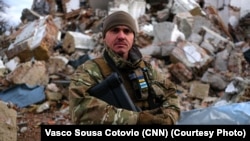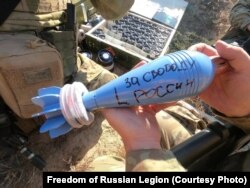For weeks, some of the most intense fighting in the war in Ukraine has centered on the Donetsk region city of Bakhmut, which Russian forces seem determined to capture even at enormous cost. The nearly deserted city is being held by Ukrainian forces, including Russian volunteers serving in the Free Russia legion and fighting against the invading forces of their own country.
The complexion of the fighting has changed since Russian President Vladimir Putin announced military mobilization in September, bringing tens of thousands of additional soldiers to the Russian lines. In addition, the ostensibly private Wagner mercenary group has recruited tens of thousands of convicts from Russian prisons and seems to be spearheading the drive to capture Bakhmut.
“We can feel the difference since mobilization,” said a Free Russian fighter in Bakhmut who goes by the call sign Tsezar, which means Caesar in English. “Now you can just shoot without aiming and you’ll definitely hit someone. Earlier we had to search for targets to corner Russian groups. Now, there are a lot of them – in every hole.”
“They have been able to advance a bit, but at the cost of enormous losses,” he added. “I feel sorry for the poor guys. I would like to be able to tell them: ‘You have no enemies in Ukraine. There are no enemies in Paris or New York. All of your enemies are sitting in the Kremlin.”
The Free Russia legion was formed in March 2022. According to Ukrainian sources, the first members were soldiers who defected from the Russian military shortly after Moscow launched its massive, unprovoked invasion on February 24. In their manifesto, they describe themselves as “free citizens of Russia who take responsibility for themselves and are beginning to fight for a New Russia.”
The exact number of fighters in the organization is held secret, but media reports mention figures up to 4,000. Tsezar, a 50-year-old from St. Petersburg who describes himself as a “Russian nationalist,” told RFE/RL’s Russian Service that he joined the legion’s “second battalion” and now “the third and fourth are being formed.” Numbers differ from country to country, but a battalion often consists of several hundred and up to 1,000 troops.
“They are all different people,” he said when asked who has joined the legion. “They all have different fates, but we are united by one goal -- to defend Ukraine and then return to Russia with weapons in our hands.”
“Russia has discredited itself and there cannot be any normal transfer of power there,” he added. “They will cling to it tightly and are ready to sacrifice millions of people to hold on.”
'I'm Done With Russia'
Tikhy, which means quiet or calm in English, is the call sign of another Free Russia fighter from the Volga River city of Tolyatti. When Moscow’s invasion began in February 2022, he was working on a construction site in Kyiv.
“At first, I simply couldn’t believe it,” he recalled. “Only after the third rocket flew by did I understand what was happening. I gathered up my family and we hid in the basement.”
In late spring, he joined the legion. He spent a few weeks training and was then sent to the front, where he has been ever since.
“I’m done with Russia. I don’t even want to hear about it after what they did in the Kyiv region and elsewhere,” Tikhy said when asked if he ever expects to see his homeland again, referring to compelling evidence that Russian forces committed atrocities in areas that they occupied, including Kyiv region towns such as Bucha.
Tsezar joined the legion around the same time.
“February 24 came as a shock,” he said. “My children were looking at me with tears and asking: ‘Papa, how can this be? How could Russia attack Ukraine?’ I told them not to worry because Ukraine would win in the end.”
“I couldn’t just stand by,” he said. “I tried to volunteer for the international legion, but they weren’t taking Russians then. When Free Russia was formed, I applied, went through some background checks, and ended up here.”
Putin 'Raised The Stakes'
The two men now form a mortar crew squaring off against raw Russian troops.
“Putin really raised the stakes with mobilization,” Tsezar said. “Earlier, we were fighting against the so-called ‘little green men’ and some Vasya was sitting in Saratov watching television,” he said, using a diminutive of the common Russian first name Vasily.
“Now Vasya has to get off his butt and crawl around a cold trench outside of Bakhmut while Tikhy and I fire mortars at him,” he said. “Vasya’s attitude is going to change. If Vasya really thinks about it, maybe he’ll join us and we’ll march together on Moscow.”
Despite taking up arms against the Russian military and government, Tzesar insisted he remained a right-leaning Russian nationalist who looks back nostalgically on the tsarist era.
“What are the Russian provinces?” he said. “Dirt, ruins, poverty, drunkenness. That is what we need to be working on, rather than expanding our prison to include Georgia, Ukraine, the Baltic states, and Belarus. That is the kind of Russian nationalist that I am…. There is no sense in using force to hold people that don’t want to be with you.”
Tzesar remained confident in Ukraine’s ultimate victory, but urged Kyiv’s allies to provide more advanced weaponry.
“You saw how 20 or 30 HIMARS units changed the course of the war,” he said, referring to the U.S.-made multiple rocket launchers that helped Ukraine bounce back after the initial invasion. “And the West has hundreds more. And thousands of tanks. I won’t even mention aircraft.”
“If Ukraine had even a tiny fraction of these weapons, Tikhy and I would be celebrating our victory somewhere on a beach in Crimea,” he said.





!["[W]e are united by one goal -- to defend Ukraine and then return to Russia with weapons in our hands,” says Tsezar from the Free Russia legion.](https://gdb.rferl.org/069c0000-0aff-0242-cb1a-08db02193c54_w250_r0_s.jpg)









